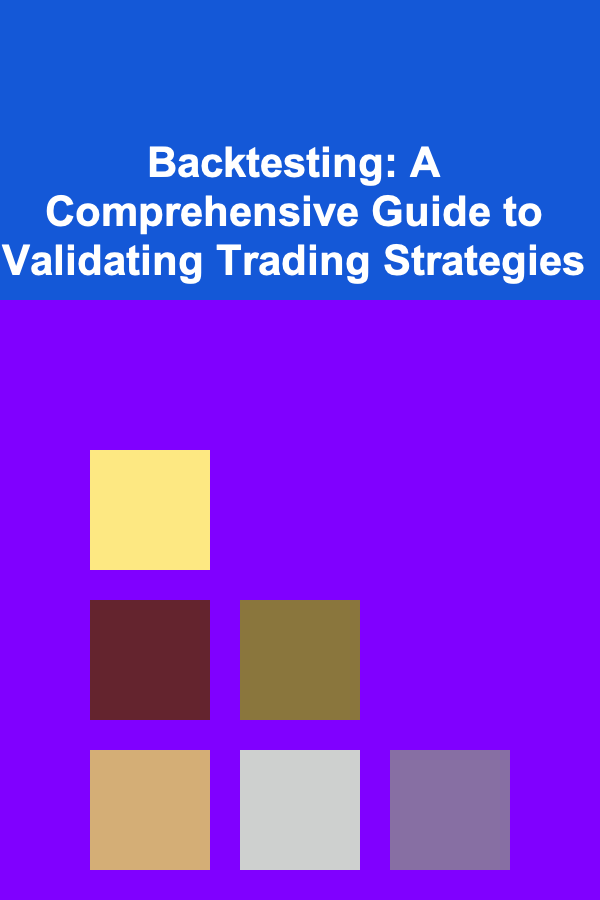
Backtesting: A Comprehensive Guide to Validating Trading Strategies
ebook include PDF & Audio bundle (Micro Guide)
$12.99$10.99
Limited Time Offer! Order within the next:

Backtesting is a crucial process in the development and validation of trading strategies. It involves simulating a trading strategy's performance on historical data to assess its potential profitability and risk characteristics before deploying it in live markets. This comprehensive guide delves into the intricacies of backtesting, covering its purpose, methodology, limitations, and best practices. We will explore the various aspects of backtesting, providing a deep understanding of how to effectively use this powerful tool to improve your trading outcomes.
The Importance of Backtesting
Backtesting offers several critical advantages for traders and investors:
- Strategy Validation: It helps to validate the core logic of a trading strategy by demonstrating its performance across different market conditions. A profitable backtest provides a degree of confidence that the strategy has merit.
- Risk Assessment: Backtesting allows you to estimate the potential risks associated with a strategy, such as drawdown (peak-to-trough decline in capital), volatility, and maximum loss. Understanding these risks is essential for proper risk management.
- Parameter Optimization: Many trading strategies rely on specific parameters. Backtesting allows you to optimize these parameters by testing different values on historical data to find the settings that yield the best performance.
- Strategy Refinement: By analyzing the results of backtests, you can identify weaknesses in your strategy and refine its rules to improve its profitability and robustness.
- Avoidance of Costly Mistakes: Backtesting can prevent you from deploying a flawed strategy in live trading, which could result in significant financial losses. It's a much safer and more cost-effective way to test your ideas.
- Emotional Detachment: Backtesting removes the emotional element from trading. You are evaluating the strategy's performance objectively, based on historical data, rather than making decisions based on fear or greed.
The Backtesting Process: A Step-by-Step Guide
A robust backtesting process typically involves the following steps:
-
Define the Trading Strategy: Clearly articulate the rules of your trading strategy. This includes entry criteria, exit criteria (stop-loss and take-profit levels), position sizing rules, and any filters or conditions that must be met before a trade is executed. Ambiguity in the rules can lead to inconsistent results and invalidate the backtest.
-
Gather Historical Data: Obtain historical data for the assets you intend to trade. The quality and accuracy of the data are paramount. Ensure that the data is clean, free of errors, and covers a sufficiently long period to capture various market conditions (bull markets, bear markets, sideways trends). Consider using data from multiple sources to verify its accuracy. The historical data should include:
- Open, High, Low, Close (OHLC) prices: These are fundamental for most price-based strategies.
- Volume: Volume data can be used to confirm price movements and identify potential trading opportunities.
- Adjusted Prices: If the data spans periods where corporate actions such as stock splits or dividends occurred, use adjusted prices to avoid artificial gaps in the price series.
-
Choose a Backtesting Platform: Select a suitable backtesting platform. There are various options available, ranging from simple spreadsheet-based solutions to sophisticated software platforms and programming libraries. Consider factors such as:
- Ease of Use: How easy is it to define and test your strategy?
- Data Integration: Does the platform integrate with your preferred data sources?
- Customization: Can you customize the backtesting environment and generate detailed reports?
- Cost: What is the cost of the platform, and does it fit within your budget?
- Supported Asset Classes: Does the platform support the asset classes you want to trade (e.g., stocks, forex, futures, cryptocurrencies)?
Popular backtesting platforms include:
- Spreadsheets (e.g., Microsoft Excel, Google Sheets): Suitable for simple strategies and manual backtesting.
- TradingView: A popular web-based platform with built-in backtesting capabilities and a large community of users.
- MetaTrader 4/5 (MT4/MT5): Widely used platforms for forex trading with algorithmic trading capabilities (Expert Advisors).
- Thinkorswim (TD Ameritrade): A powerful platform with advanced charting and backtesting tools.
- Python with libraries like Backtrader, Zipline, and PyAlgoTrade: Offers maximum flexibility and control for advanced users who are comfortable with programming.
-
Implement the Strategy in the Platform: Translate your trading strategy's rules into the language of the chosen backtesting platform. This may involve writing code (e.g., Python, MQL4/5) or using a visual strategy builder. Ensure that the implementation accurately reflects the intended logic of your strategy. Thoroughly test the code to identify and fix any bugs or errors.
-
Run the Backtest: Execute the backtest on the historical data. The platform will simulate the trading strategy's performance, generating a series of trades based on the defined rules.
-
Analyze the Results: Carefully analyze the results of the backtest. Pay attention to key performance metrics such as:
- Total Return: The overall percentage gain or loss generated by the strategy.
- Annualized Return: The average annual return, adjusted for compounding.
- Maximum Drawdown: The largest peak-to-trough decline in capital during the backtesting period. This is a critical measure of risk.
- Sharpe Ratio: A risk-adjusted return metric that measures the excess return per unit of risk (volatility). A higher Sharpe ratio indicates better risk-adjusted performance.
- Win Rate: The percentage of winning trades.
- Profit Factor: The ratio of gross profit to gross loss. A profit factor greater than 1 indicates that the strategy is profitable on average.
- Average Trade Length: The average duration of trades.
- Number of Trades: The total number of trades executed during the backtesting period. A higher number of trades generally provides more statistical significance.
-
Optimize and Refine: Based on the analysis of the results, optimize the strategy's parameters and refine its rules. Experiment with different parameter values and modifications to the strategy's logic to improve its performance. Be cautious of overfitting (discussed below).
-
Walk-Forward Optimization (Optional): To mitigate the risk of overfitting, consider using walk-forward optimization. This involves dividing the historical data into multiple periods. You optimize the strategy on the first period, test it on the second period, and then repeat the process by rolling the periods forward. This provides a more realistic assessment of the strategy's out-of-sample performance.
-
Stress Testing: Subject the strategy to stress testing by simulating its performance under extreme market conditions (e.g., market crashes, sudden volatility spikes). This helps to assess its robustness and identify potential vulnerabilities.
-
Document Everything: Thoroughly document the entire backtesting process, including the strategy rules, data sources, platform used, parameter settings, and results. This documentation will be invaluable for future reference and analysis.
Avoiding Overfitting: The Biggest Pitfall in Backtesting
Overfitting is a common and significant problem in backtesting. It occurs when a strategy is optimized to perform exceptionally well on the specific historical data used for the backtest, but fails to perform as well in live trading or on different data sets. An overfit strategy is essentially memorizing the past rather than identifying true, underlying market patterns.
Here are some key signs of overfitting:
- Extremely High Win Rate: A win rate that is significantly higher than what is typically achievable in the market.
- Unrealistic Profit Factor: A profit factor that is excessively high.
- Complex Strategy Rules: Strategies with overly complex rules are more prone to overfitting because they have more parameters that can be fine-tuned to the historical data.
- Sensitivity to Parameter Changes: A strategy whose performance changes dramatically with small changes in its parameters is likely overfit.
- Poor Out-of-Sample Performance: The strategy performs poorly when tested on data that was not used for optimization (out-of-sample data).
To mitigate the risk of overfitting, consider the following techniques:
- Use a Sufficiently Long Backtesting Period: A longer backtesting period provides more data and helps to capture a wider range of market conditions.
- Keep Strategies Simple: Favor simpler strategies with fewer parameters. Simpler strategies are less likely to be overfit and are often more robust.
- Walk-Forward Optimization: As mentioned earlier, walk-forward optimization is a powerful technique for reducing overfitting.
- Out-of-Sample Testing: Always test the strategy on data that was not used for optimization. This provides a more realistic assessment of its performance. Divide your data into three sets:
- Training Set: Used for developing and optimizing the strategy.
- Validation Set: Used for fine-tuning the strategy and selecting the best parameter settings.
- Test Set: Used for final evaluation of the strategy's performance on unseen data.
- Regularization Techniques: In machine learning-based strategies, regularization techniques can help to prevent overfitting by penalizing complex models.
- Understand Market Fundamentals: Ensure that the strategy's logic is grounded in sound market principles and makes sense from a fundamental perspective. Avoid blindly optimizing parameters without understanding why they work.
- Limit the Number of Parameters: Avoid using too many parameters in your strategy. Each parameter adds complexity and increases the risk of overfitting.
The Importance of Data Quality
The accuracy and reliability of historical data are critical for backtesting. Garbage in, garbage out -- if the data is flawed, the results of the backtest will be meaningless. Here are some important considerations regarding data quality:
- Data Source: Choose reputable data providers that offer high-quality data. Consider using data from multiple sources to verify its accuracy.
- Data Errors: Check the data for errors, such as missing data points, incorrect prices, and duplicate entries. Clean the data before using it for backtesting.
- Data Adjustments: If the data spans periods where corporate actions such as stock splits or dividends occurred, use adjusted prices to avoid artificial gaps in the price series.
- Tick Data vs. Bar Data: Tick data (every transaction) provides the most granular view of price movements, but it can be very large and computationally intensive to process. Bar data (e.g., 1-minute, 5-minute, daily) is a more aggregated form of data and is often sufficient for backtesting most strategies. The choice depends on the strategy's frequency and sensitivity to short-term price fluctuations.
- Look-Ahead Bias: Avoid look-ahead bias, which occurs when the strategy uses information that would not have been available at the time the trade was executed. For example, using closing prices to make entry decisions during the trading day.
- Data Consistency: Ensure that the data is consistent across different time periods and asset classes.
Choosing the Right Backtesting Platform
The choice of backtesting platform depends on your specific needs and technical expertise. Here's a more detailed look at some popular options:
- Spreadsheets (e.g., Microsoft Excel, Google Sheets):
- Pros: Simple, familiar, easy to use for basic calculations and analysis.
- Cons: Limited scalability, difficult to automate complex strategies, prone to errors, time-consuming for large datasets. Not suitable for high-frequency trading.
- Use Case: Testing very simple strategies with a limited number of trades. Useful for manual backtesting and visualization.
- TradingView:
- Pros: Web-based, user-friendly interface, built-in Pine Script language for strategy development, large community of users, integrates with many brokers.
- Cons: Limited customization options, can be expensive for advanced features, Pine Script has some limitations.
- Use Case: Testing and sharing trading ideas, developing and backtesting moderately complex strategies.
- MetaTrader 4/5 (MT4/MT5):
- Pros: Widely used for forex trading, algorithmic trading capabilities (Expert Advisors), MQL4/5 programming language, large library of indicators and strategies.
- Cons: MQL4/5 can be challenging to learn, limited support for other asset classes, backtesting engine can be slow.
- Use Case: Developing and backtesting forex trading strategies, automating trading on MT4/MT5 platforms.
- Thinkorswim (TD Ameritrade):
- Pros: Powerful platform with advanced charting and backtesting tools, ThinkScript language, supports a wide range of asset classes.
- Cons: Can be complex to learn, requires a TD Ameritrade account.
- Use Case: Developing and backtesting advanced trading strategies across various asset classes.
- Python with libraries like Backtrader, Zipline, and PyAlgoTrade:
- Pros: Maximum flexibility and control, access to a vast ecosystem of Python libraries for data analysis and machine learning, can handle large datasets, highly customizable.
- Cons: Requires programming knowledge, steeper learning curve, more time-consuming to set up and implement.
- Use Case: Developing and backtesting complex, data-driven trading strategies, conducting advanced research and analysis. Ideal for quantitative traders.
Beyond Backtesting: Forward Testing and Live Trading
Backtesting is just the first step in validating a trading strategy. It's essential to follow it up with forward testing and live trading before committing significant capital.
- Forward Testing (Paper Trading): Forward testing involves simulating the strategy's performance in real-time, using live market data, but without risking any real money. This allows you to observe how the strategy performs in a live trading environment and to identify any issues that may not have been apparent during backtesting.
- Live Trading (with Small Capital): Once you are confident in the strategy's performance in forward testing, you can begin live trading with a small amount of capital. This allows you to gain real-world experience and to fine-tune the strategy's execution. Gradually increase the position size as you gain more confidence.
Conclusion: Backtesting as a Continuous Process
Backtesting is not a one-time event, but rather a continuous process of strategy development, validation, and refinement. Market conditions change over time, so it's essential to regularly re-evaluate your strategies and adapt them as needed. By embracing backtesting as an integral part of your trading process, you can significantly improve your chances of success in the markets.
Remember these key takeaways:
- Define your strategy clearly and unambiguously.
- Use high-quality historical data.
- Choose the right backtesting platform.
- Avoid overfitting.
- Thoroughly analyze the results.
- Continuously refine and optimize your strategies.
- Follow up with forward testing and live trading.
By following these guidelines, you can harness the power of backtesting to develop and validate profitable and robust trading strategies.
Reading More From Our Other Websites
- [Tiny Home Living Tip 101] How to Plan a Tiny Home Garden for Year‑Round Harvest
- [Home Soundproofing 101] How to Soundproof Your Home for Peaceful Music Practice
- [Home Soundproofing 101] How to Create a Soundproof Home Office for Maximum Productivity
- [Home Budget Decorating 101] How to Create a Minimalist Home Decor Style on a Budget
- [Screen Printing Tip 101] Eco‑Friendly Screen Printing: Sustainable Materials and Methods for Green Artists
- [Home Cleaning 101] How to Clean Your Home in 30 Minutes a Day
- [Personal Investment 101] Monetizing Deep Learning: The Ultimate Passive Income Blueprint
- [Horseback Riding Tip 101] Riding with Respect: Common Etiquette Mistakes and How to Avoid Them
- [Toy Making Tip 101] DIY Toy Engineering: How to Turn a Conceptual Design into a Working Prototype
- [Hiking with Kids Tip 101] Family-Friendly Hikes Under 5 Miles: Quick Escapes for Busy Parents

Beginner's Guide to Online Marketing
Read More
Financial Control Excellence: A Comprehensive Guide for Financial Controllers
Read More
How to Boost Your Energy with Proper Nutrition
Read More
How to Create a Family Emergency Plan and Kit
Read More
How to Navigate Climate Anxiety and Eco-Grief
Read More
The Art of Homemade Tortillas: A Deep Dive into Tradition and Flavor
Read MoreOther Products

Beginner's Guide to Online Marketing
Read More
Financial Control Excellence: A Comprehensive Guide for Financial Controllers
Read More
How to Boost Your Energy with Proper Nutrition
Read More
How to Create a Family Emergency Plan and Kit
Read More
How to Navigate Climate Anxiety and Eco-Grief
Read More